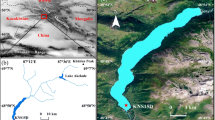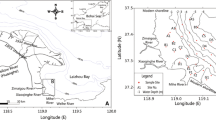Abstract
The grain-size distribution of the sediments of closed lake basins is sensitive to lake-level changes and thus to changes in regional climate. Deep-water areas of lakes potentially yield high resolution, continuous records of sedimentation and lake-level changes. In contrast, the marginal areas of lake basins accumulate sediment in a wave-dominated, high-energy environment and may be more sensitive to lake-level changes than deep-water environments, but they might also be more affected by sedimentary hiatuses. Here, we present grain-size data from two sections of exposed nearshore sediments of Dali Lake, North China, and compare them with previously published results from a sediment core from the lake center. We used the grain size-standard deviation method to distinguish various grains-size components of the nearshore sediments, and compared the results with those from surface sediments from various depths in order to investigate past lake-level changes. Combining the grain-size results with a radiocarbon chronology, we defined four lake-level stages during the Holocene: (1) An intermediate lake level from early Holocene to 10.0 cal ka BP. (2) A high lake level from 10.0 to 6.6 cal ka BP. (3) A decline to an intermediate lake level from 6.6 to 1.0 cal ka BP. (4) An abrupt fall to a low lake level from 1.0 cal ka BP to the present when the marginal section was covered with eolian sand. Our results indicate that the total amplitude of lake-level variation during the Holocene was greater than 45 m. This record of lake-level change is in good agreement with previous results obtained from the lake center, and it indicates that the grain-size standard deviation method may be well suited for lake-level reconstruction from nearshore sediments. Moreover, the marginal sections provide evidence of an abrupt short-lived lake-level decline more clearly than the deep-water core.








Similar content being viewed by others
References
An FY, Ma HZ, Wei HC, Lai ZP (2012) Distinguishing aeolian signature from lacustrine sediments of the Qaidam Basin in northeastern Qinghai-Tibetan Plateau and its palaeoclimatic implications. Aeolian Res 4:17–30
Ashley GM (1978) Interpretation of polymodal sediments. J Geol 86:411–421
Bacon SN, Burke RM, Pezzopane SK, Jayko AS (2006) Last glacial maximum and Holocene lake levels of Owens Lake, eastern California, USA. Quat Sci Rev 25:1264–1282
Benson LV, Smoot JP, Lund SP, Mensing SA, Foit FF, Rye RO (2013) Insights from a synthesis of old and new climate-proxy data from the Pyramid and Winnemucca lake basins for the period 48 to 11.5 cal ka. Quat Int 310:62–82
Berger A, Loutre M (1991) Insolation values for the climate of the last 10 million years. Quat Sci Rev 10:297–317
Boulay S, Colin C, Trentesaux A, Pluquet F, Bertaux J, Blamart D, Buehring C, Wang P (2003) Mineralogy and sedimentology of Pleistocene sediment in South China Sea. Proc ODP Sci Results 184:1–21
Campbell C (1998) Late Holocene lake sedimentology and climate change in southern Alberta, Canada. Quat Res 49:96–101
Chu GQ, Sun Q, Xie MM, Lin Y, Shang WY, Zhu QZ, Shan YB, Xu DK, Rioual P, Wang L, Liu JQ (2014) Holocene cyclic climatic variations and the role of the Pacific Ocean as recorded in varved sediments from northeastern China. Quat Sci Rev 102:85–95
Cohen AS (2003) Paleolimnology: the history and evolution of lake systems. Oxford University Press, New York 528 pp
Compilatory Commission of Annals Banner (1993) Annals of Hexigten Banner. People’s Press of Inner Mongolia, Hohhot, pp 97–106 (in Chinese)
Dong JG, Wang YJ, Cheng H, Hardt B, Edwards RL, Kong XG, Wu JY, Chen ST, Liu DB, Jiang XY (2010) A high-resolution stalagmite record of the Holocene East Asian monsoon from Mt Shennongjia, central China. The Holocene 20:257–264
Dykoski CA, Edwards RL, Cheng H, Yuan DX, Cai YJ, Zhang ML, Lin YS, Qing J, An ZS, Revenaugh J (2005) A high-resolution, absolute-dated Holocene and deglacial Asian monsoon record from Dongge Cave, China. Earth Planet Sci Lett 233:71–86
Folk RL, Ward WC (1957) Brazos River bar: a study in the significance of grain size parameters. J Sediment Petrol 27:3–26
Geng K, Zhang ZC (1988) The geomorphic characteristics and evolution of the lakes in Dalairuoer area of Neimenggu Plateau during the Holocene. J Beijing Norm Univ (Nat Sci Ed) 4:94–101 (in Chinese)
Håkanson L, Jansson M (1983) Principles of lake sedimentology. Springer, Berlin 316 pp
Howitt D, Cramer D (2008) Introduction to SPSS in psychology: for version 16 and earlier. Pearson Education, Harlow 377 pp
Jiang WY, Guo ZT, Sun XJ, Wu HB, Chu GQ, Yuan BY, Hatté C, Guiot J (2006) Reconstruction of climate and vegetation changes of Lake Bayanchagan (Inner Mongolia): holocene variability of the East Asian monsoon. Quat Res 65:411–420
Jiang WY, Guiot J, Chu GQ, Wu HB, Yuan BY, Hatté C, Guo ZT (2010) An improved methodology of the modern analogues technique for palaeoclimate reconstruction in arid and semi-arid regions. Boreas 39:145–153
Krumbein WC (1938) Size frequency distributions of sediments and the normal phi curve. J Sediment Res 8:84–90
Li RQ, Zheng LM, Zhu GR (1990) Lakes and environmental changes in Inner Mongolia Plateau. Beijing Normal University Press, Beijing, pp 45 (in Chinese)
Liu SL, Wang T, Guo J (2006) Characteristics of blown sand activities in Hunshandake Sandy Land in spring. J Desert Res 26:356–361 (in Chinese)
Liu XQ, Dong HL, Yang XD, Herzschuh U, Zhang EL, Stuut JW, Wang YB (2009) Late Holocene forcing of the Asian winter and summer monsoon as evidenced by proxy records from the northern Qinghai-Tibetan Plateau. Earth Planet Sci Lett 280:276–284
Liu SZ, Deng CL, Xiao JL, Li JH, Paterson GA, Chang L, Yi L, Qin HF, Pan YX, Zhu RX (2015) Insolation driven biomagnetic response to the Holocene Warm Period in semi-arid East Asia. Sci Rep 5:8001
Ma L, Wu JL, Wen JH, Liu W, Jilili A (2013) Grain size characteristics and its environmental significance of lacustrine sediment recorded in Wuliangsu Lake, Inner Mongolia. Acta Sedimentol Sin 31:646–652 (in Chinese)
Middleton GV (1976) Hydraulic interpretation of sand size distributions. J Geol 84:405–426
Mook WG, Streurman HJ (1983) Physical and chemical aspects of radiocarbon dating. In: Proceedings of the first international symposium 14 C and archaeology. Council of Europe, Groningen, 1981, pp 31–55
Negrini RM, Wigand PE, Draucker S, Gobalet K, Gardner JK, Sutton MQ, Yohe RM II (2006) The Rambla highstand shoreline and the Holocene lake-level history of Tulare Lake, California, USA. Quat Sci Rev 25:1599–1618
Nishizawa S, Currey DR, Brunelle A, Sack D (2013) Bonneville basin shoreline records of large lake intervals during Marine Isotope Stage 3 and the Last Glacial Maximum. Palaeogeogr Palaeoclimatol Palaeoecol 386:374–391
Oldfield F, Crooks PRJ, Harkness DD, Petterson G (1997) AMS radiocarbon dating of organic fractions from varved lake sediments: an empirical test of reliability. J Paleolimnol 18:87–91
Peng YJ, Xiao JL, Nakamura T, Liu BL, Inouchi Y (2005) Holocene East Asian monsoonal precipitation pattern revealed by grain-size distribution of core sediments of Daihai Lake in Inner Mongolia of north-central China. Earth Planet Sci Lett 233:467–479
Qin XG, Cai BG, Liu TS (2005) Loess record of the aerodynamic environment in the east Asia monsoon area since 60,000 years before present. J Geophys Res 110:B01204. doi:10.1029/2004JB003131
Ramsey CB (2009) Bayesian analysis of radiocarbon dates. Radiocarbon 51:337–360
Reheis MC, Bright J, Lund SP, Miller DM, Skipp G, Fleck RJ (2012) A half-million-year record of paleoclimate from the Lake Manix core, Mojave Desert, California. Palaeogeogr Palaeoclimatol Palaeoecol 365–366:11–37
Reheis MC, Adams KD, Oviatt CG, Bacon SN (2014) Pluvial lakes in the Great Basin of the western United States—a view from the outcrop. Quat Sci Rev 97:33–57
Reimer PJ, Bard E, Bayliss A, Beck JW, Blackwell PG, Ramsey CB, Buck CE, Cheng H, Edwards RL, Friedrich M (2013) IntCal13 and Marine13 radiocarbon age calibration curves 0–50,000 years cal BP. Radiocarbon 55:1869–1887
Sun QL, Zhou J, Xiao JL (2001) Grain-size characteristics of Lake Daihai sediments and its paleaoenvironment significance. Mar Geol Quat Geol 21:93–95 (in Chinese)
Sun DH, Bloemendal J, Rea DK, Vandenberghe J, Jiang FC, An ZS, Su RX (2002) Grain-size distribution function of polymodal sediments in hydraulic and aeolian environments, and numerical partitioning of the sedimentary components. Sediment Geol 152:263–277
Sun YB, Gao S, Li J (2003) Preliminary analysis on sensitive grain size component of terrigenous material from marginal sea. Chin Sci Bull 48:83–86 (in Chinese)
Tang L, Wang XS, Zhang SQ, Chu GQ, Chen Y, Pei JL, Sheng M, Yang ZY (2015) High-resolution magnetic and palynological records of the last deglaciation and Holocene from Lake Xiarinur in the Hunshandake Sandy Land, Inner Mongolia. The Holocene. doi:10.1177/0959683615571426
Visher SG (1969) Grain-size distribution and depositional processes. J Sediment Res 39:1074–1106
Wang HY, Liu HY, Zhu JL, Yin Y (2010) Holocene environmental changes as recorded by mineral magnetism of sediments from Anguli-nuur Lake, southeastern Inner Mongolia Plateau, China. Palaeogeogr Palaeoclimatol Palaeoecol 285:30–49
Wang JZ, Wu JL, Zeng HA (2014) Grain size characteristics and its environmental significance of Lake Chengpuhai sediments in Hetao Plain, Inner Mongolia. Mar Geol Quat Geol 34:137–144 (in Chinese)
Wei YM, Song CQ (1992) Neotectonic movement and lake evolution in Palaeo-Jingpeng Lake area, Inner-Mongolia. Arid Land Geography 15:34–41 (in Chinese)
Weltje GJ (1997) End-member modeling of compositional data: numerical-statistical algorithms for solving the explicit mixing problem. Math Geol 29:504–549
Wen RL, Xiao JL, Chang ZG, Zhai DY, Xu QH, Li YC, Itoh S, Lomtatidze Z (2010) Holocene climate changes in the mid-high-latitude-monsoon margin reflected by the pollen record from Hulun Lake, northeastern Inner Mongolia. Quat Res 73:293–303
Xiao JL, Xu QH, Nakamura T, Yang XL, Liang WD, Inouchi Y (2004) Holocene vegetation variation in the Daihai Lake region of north-central China: a direct indication of the Asian monsoon climatic history. Quat Sci Rev 23:1669–1679
Xiao JL, Si B, Zhai DY, Itoh S, Lomtatidze Z (2008) Hydrology of Dali Lake in central-eastern Inner Mongolia and Holocene East Asian monsoon variability. J Paleolimnol 40:519–528
Xiao JL, Chang ZG, Si B, Qin XG, Itoh S, Lomtatidze Z (2009) Partitioning of the grain-size components of Dali Lake core sediments: evidence for lake-level changes during the Holocene. J Paleolimnol 42:249–260
Xiao JL, Fan JW, Zhai DY, Wen RL, Qin XG (2015) Testing the model for linking grain-size component to lake level status of modern clastic lakes. Quat Int 355:34–43
Yang XP, Scuderi LA, Wang XL, Scuderi LJ, Zhang DG, Li HW, Forman S, Xu QH, Wang RC, Huang WW, Yang SX (2015) Groundwater sapping as the cause of irreversible desertification of Hunshandake Sandy Lands, Inner Mongolia, northern China. Proc Natl Acad Sci 112:702–706
Zhang CJ, Zhang WY, Feng ZD, Mischke S, Gao X, Gao D, Sun FF (2012) Holocene hydrological and climatic change on the northern Mongolian Plateau based on multi-proxy records from Lake Gun Nuur. Palaeogeogr Palaeoclimatol Palaeoecol 323–325:75–86
Zhen ZL, Zhang S, Shi XH, Sun B (2013) Research on the evolution of Dali Lake area based on the remote sensing technology. China Rural Water Hydropower 7:6–9 (in Chinese)
Zhen ZL, Li CY, Li WB, Hu QT, Liu XX, Liu ZJ, Yu RX (2014) Characteristics of environmental isotopes of surface water and groundwater and their recharge relationships in Lake Dali basin. J Lake Sci 26:916–922 (in Chinese)
Acknowledgments
We thank Oliver Heiri and three anonymous referees for valuable comments and suggestions that helped improve the early version of the manuscript. Special thanks are extended to Thomas J Whitmore and Oliver Heiri for their careful revision of the manuscript. This study was financially supported by the Grants from the Geological Investigation Projects of China Geological Survey (Nos. 12120113005600, 1212011120142, 121201102000150010-07).
Author information
Authors and Affiliations
Corresponding author
Rights and permissions
About this article
Cite this article
Liu, J., Wang, Y., Li, T. et al. Comparison of grain-size distributions between nearshore sections and a deep-water sediment core from Dali Lake, North China, and inferred Holocene lake-level changes. J Paleolimnol 56, 123–135 (2016). https://doi.org/10.1007/s10933-016-9899-x
Received:
Accepted:
Published:
Issue Date:
DOI: https://doi.org/10.1007/s10933-016-9899-x




